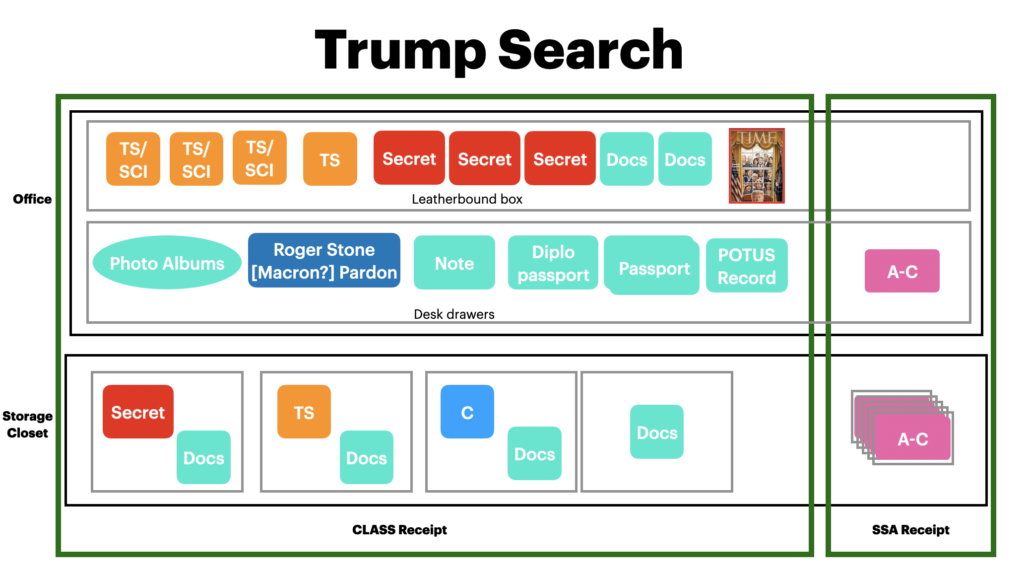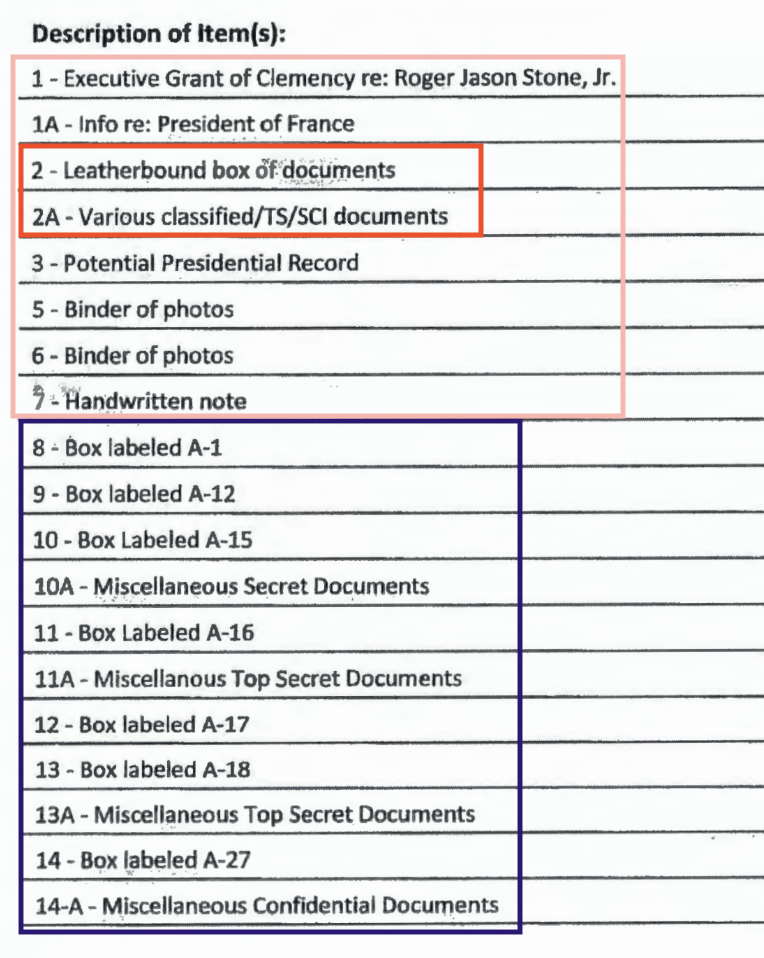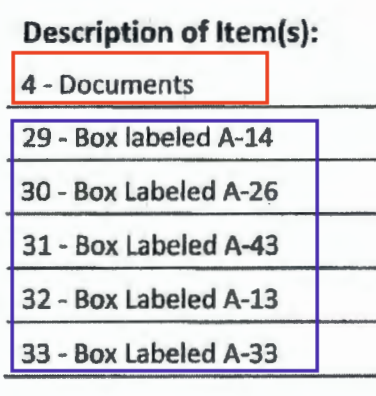As I noted in my first post on Wednesday’s DOJ response to Trump’s bid to get a Special Master, the filing provides more details about what the FBI found where.
I’ve updated my nifty graphic accordingly.
As a reminder, this graphic attempts to show with horizontal boxes where things were seized, and with vertical boxes, to show where they were cataloged. The original search inventory was catalogued on two different receipts: one — which I refer to as the CLASS receipt — on which all boxes described to contain documents marked as classified were listed, and another — which I refer to as the SSA receipt because the Supervisory Special Agent signed it — which Fox News subsequently reported was where all the potentially privileged materials were catalogued. Once emptywheel gets a graphics department, I’ll update this to reflect 22 boxes were found in the storage room.
While we can’t be entirely certain, it appears that further sorting of the items on the SSA receipt of potentially privileged items has identified two more boxes and 3 additional documents marked as classified.
Another thing I think we can say is that the FBI found Roger Stone in Trump’s desk drawer, not some dusty box stored in a converted bomb shelter.
According to the filing, FBI seized classified materials from just two rooms: Trump’s office and a storage closet.
[C]lassified documents were found in both the Storage Room and in the former President’s office.
The filing also makes clear that the TS/SCI documents in the picture included as an appendix came from a container seized from Trump’s office.
See, e.g., Attachment F (redacted FBI photograph of certain documents and classified cover sheets recovered from a container in the “45 office”).
That helps us sort out the locations of the items seized in the search. The label “2A” in the picture confirms the container in question is item 2 on the inventory, the leatherbound box, which is further confirmed because that box was the only one in the entire inventory described to enclose TS/SCI documents. So that also makes clear (as I suspected) that the leatherbound box was seized in Trump’s office.
In part based on known FBI search processes and the role of proximity in this search protocol, we can surmise that the other items lacking an A-prefix were also seized in Trump’s office (items 1 through 7 here, plus item 4, described only as “documents,” on the SSA receipt that we know lists the items originally identified as potentially including privileged material). It’s hypothetically possible that some of those items were seized in Trump’s residence, but in part because the filter team only searched Trump’s office and in part because there’s not a second series of numbers from a room identified as “B,” I think it more likely this stuff was in Trump’s office.
Given that the only other location from which classified documents were seized was the storage room, it suggests all the A-prefix boxes were seized there. Again, that makes sense given what we know of FBI processes: they label a room with a letter, then label the items in that room by letter and number. There were at least 73 boxes or other items searched in that storage room.
So the first page of what I call the CLASS receipt, the items outlined in red would have been found in Trump’s office, and the items outlined in purple would have been found in the storage room. Everything else on the CLASS receipt, too, would have been seized from the storage room.
And the SSA receipt included some number of documents seized from Trump’s office that filter agents wanted to review some more, as well as five boxes that, for some reason, investigative agents stopped searching and brought to the filter team to handle.
If all that’s right, it means that DOJ seized 26 (out of at least 73) boxes from the storage room, and seven items total (one of which was described as “documents,” plural, on the SSA privileged receipt) from Trump’s office, for a total of 33.
I’ll come back to that number, 33.
From that inventory, according to DOJ’s filing, 13 boxes include documents marked as classified, and all told, the FBI collected over 100 documents marked classified on August 8.
Of the Seized Evidence, thirteen boxes or containers contained documents with classification markings, and in all, over one hundred unique documents with classification markings—that is, more than twice the amount produced on June 3, 2022, in response to the grand jury subpoena—were seized.
Those over 100 break down this way, by location:
- 76 documents found in boxes in the storage room
- 3 documents (individually) found in desk drawer(s) in Trump’s office
- At least 22 documents in the leatherbound box (I count around 23 from the picture)
It’s the number of total boxes with documents marked as classified, 13, that can’t be reliably broken down.
That’s because DOJ’s filing describes two more boxes that contain documents marked as classified, 13, than are reflected on the receipts, which show 11. They’ve found two more since August 8. The extra two boxes may come from one of two places: either boxes on the CLASS receipt that were not previously identified to include documents marked as classified but in which one or two classified documents were discovered on closer inspection, or boxes among the five originally on the SSA receipt that, after further filter review, were subsequently discovered to have classified documents.
It doesn’t really matter in the grand scheme of things — two boxes post-privilege review or two boxes in which there’s a stray classified document shorn of its cover sheet.
But it may reflect further processing of materials on the SSA receipt.
The government’s language on this is a bit confusing. In one place, the government seems to suggest the case agents have not reviewed anything in the containers originally designated to include potentially privileged documents (though this may simply mean the investigative team has finished its scrutiny of all boxes known not to contain privileged documents, without commenting on the rest).
The investigative team has reviewed all the materials in the containers that the privilege review team did not segregate as potentially attorney-client privileged.
In another place the government filing seems to suggest that since seizing the documents, a subsequent privilege review may have freed up materials — like some of the contents of those five boxes and documents, plural, from Trump’s office — for subsequent review or, in the case of Trump’s passports, return to the subject of the investigation.
[T]he government’s filter team has already completed its work of segregating any seized materials that are potentially subject to attorney-client privilege, and the government’s investigative team has already reviewed all of the remaining materials, including any that are potentially subject to claims of executive privilege.
In a third place, the government’s filing seems to suggest that DOJ has freed up everything not identified as potentially privileged, resulting in a much smaller possible universe of potentially privileged documents than the original five boxes plus “documents” laid out on the SSA receipt.
The privilege review team has completed its review of the materials in its custody and control that were identified as potentially privileged. The privilege review team identified only a limited subset of potentially attorney-client privileged documents.
I don’t so much care about the uncertainty except insofar as the small number might thwart Trump’s efforts to stall things with a Special Master review.
But several other things suggest that after pulling six items (five boxes from the storage room and “documents” from Trump’s office) for closer review on August 8, it has since freed up things that are clearly not privileged, and along the way identified some number of documents marked as classified.
One reason that almost has to be the case is that DOJ has segregated all classified documents because it has to do so to keep them secure (which will also help prove any eventual charges against Trump).
All of the classified documents seized in the August 8 search have been segregated from the rest of the seized documents and are being separately maintained and stored in accordance with appropriate procedures for handling and storing classified information.
This seems to suggest that even for the potentially privileged documents, the filter team has at least identified if they’re classified, so they can be stored someplace more secure than a hotel safe.
Another reason that seems, necessarily, to be true is that DOJ talks about documents marked as classified. While the FBI seized three individual documents from what appears to be Trump’s desk drawer — the Roger Stone clemency, a potential Presidential Record, and a handwritten note — none of those were described as classified, which would be easy to note. They might be classified, but they are not marked as such.
Which is to say that the two boxes not identified on the CLASS receipt that, per DOJ’s filing had classified documents, may be two that also contain potentially privileged documents. And the three documents from the desk drawer that are marked as classified were among those the filter team thought might be privileged. And in fact, Trump seems to know there are potentially privileged documents that are also classified. About the only thing Trump’s lawyers agree with DOJ about, regarding a hypothetical Special Master, is that that person should have TS/SCI clearance. (Which seems to be a confession that Trump broke the law, but Trump and his lawyers are doing that a lot of late.)
That also seems to be the only way to explain the treatment of items from Trump’s office: the filter team identified things that clearly weren’t privileged — such as the leatherbound box and all its contents and two binders of photos — then seized the rest as a category, documents, that they they have since done a more attentive privilege review on.
Three classified documents that were not located in boxes, but rather were located in the desks in the “45 Office,” were also seized. Per the search warrant protocols discussed above, the seized documents included documents that were collectively stored or found together with documents with classification markings.6
6 Plaintiff repeatedly claims that his passports were outside the scope of the warrant and improperly seized, and that the government, in returning them, has admitted as much. See D.E. 1 at 2 & n.2; D.E. 28 at 3, 8, 9. These claims are incorrect. Consistent with Attachment B to the search warrant, the government seized the contents of a desk drawer that contained classified documents and governmental records commingled with other documents. The other documents included two official passports, one of which was expired, and one personal passport, which was expired. The location of the passports is relevant evidence in an investigation of unauthorized retention and mishandling of national defense information; nonetheless, the government decided to return those passports in its discretion.
That’s how it was possible to seize three passports but not have them show up on the original receipt. They were included along with those documents, plural, on the SSA receipt. But then further review made it clear that Trump’s visa stamps are not classified, and Jay Bratt returned them to Evan Corcoran.
In my nifty graphic above, I’ve put the passports where they belong, in a desk drawer in Trump’s office.
Now let’s return to DOJ’s affirmation that the total number of items seized were 33.
Remember when I wrote an entire post, based on the FBI’s Borgesian counting methods, arguing that others were making a big mistake by assuming there was one item, Roger Stone clemency for things we know about — his lying to cover up how he coordinated with Russia in 2016 — listed as item 1, and another separate item, information about a French President, listed as item 1A?
Well, the people who filed Wednesday’s filing — who presumably have DOJ’s detailed inventory in hand — tell us that the number of items seized equals 33.
During the August 8 Execution of the Search Warrant at the Premises, the Government Seized Thirty-Three Boxes, Containers, or Items of Evidence, Which Contained over a Hundred Classified Records, Including Information Classified at the Highest Levels
Pursuant to the above-described search protocols, the government seized thirty-three items of evidence, mostly boxes (hereinafter, the “Seized Evidence”), falling within the scope of Attachment B to the search warrant because they contained documents with classification markings or what otherwise appeared to be government records.
That’s precisely the number recorded on the inventory. 33.
The only way the people in possession of that more detailed inventory would assert, still, that there were 33 items on the original inventory is if item 1, Executive Grant of Clemency for Roger Jason Stone, Jr., and item 1A, info re: President of France, are the same object.
If there are 33 items, Trump granted clemency to Stone for something to do with a French President.
Let me repeat that: If the people who wrote this filing, who unlike you and I are privy to the detailed inventory of what was taken, say there were 33 items taken, then the Stone clemency itemized as item 1 in the inventory we do have contains — within it — information about a French President.
This is a pardon or some other kind of clemency that, rather than giving it to DOJ for publication, Trump stuck in a desk drawer. Not a box in a storage room. Trump had a pardon (or some other clemency) for his rat-fucker about an unknown subject relating to a French President, stashed in his desk drawer, apparently right next to his passports and three documents marked as classified that may be privileged.
And that’s one of the reasons I found DOJ’s generous offer to unseal the more detailed receipt, in the guise of sharing it with Trump, to be rather delicious.
1 Plaintiff also sought a more detailed receipt for the property seized during the August 8, 2022 execution of the search warrant. D.E. 1 at 19-21; see generally D.E. 28. The Court ordered the government to file under seal “[a] more detailed Receipt for Property specifying all property seized pursuant to the search warrant.” D.E. 29 at 2. The government filed today under seal, in accordance with the Court’s order, the more detailed receipt. Although the receipt of property already provided to Plaintiff at the time of the search, see In Re Sealed Search Warrant, No. 22-MJ-8332 (S.D. Fla.) (hereinafter, “MJ Docket”), D.E. 17 at 5-7, is sufficient under Fed. R. Crim. P. 41, the government is prepared, given the extraordinary circumstances, to unseal the more detailed receipt and provide it immediately to Plaintiff. [my emphasis]
Be careful of what you wish for, Donny, especially with the press coalition already asking Judge Cannon to unseal these sealed materials.
If Trump pardoned Roger Stone for something to do with — say — a hack-and-leak campaign, conducted in coordination with the GRU, targeting Emmanuel Macron, but then stuck the pardon in his desk drawer rather than sending it to DOJ to be published along with all his other utterly corrupt pardons, it’s not something he wants to be public. My guess is the potential Presidential Record and the handwritten note, also apparently found in his desk drawer, are similarly things Trump wouldn’t like to be public. Likewise the three classified, potentially privileged documents found in the same desk drawer, which he agrees would require a TS/SCI clearance to review.
Trump stuck his rat-fucker in his desk drawer. And now his efforts to gum up this investigation may make that public.
Update: Judge Cannon has thwarted live coverage of the hearing on this today. But NBC reported that she will not order the release of the more detailed inventory, which may suggest she recognizes it doesn’t help Trump.


